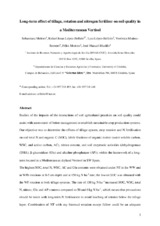Mostrar el registro sencillo del ítem
Long-term effect of tillage, rotation and nitrogen fertilizer on soil quality in a Mediterranean Vertisol
| dc.contributor.author | Melero, Sebastiana | |
| dc.contributor.author | López-Bellido Garrido, Rafael J. | |
| dc.contributor.author | López Bellido, Luis | |
| dc.contributor.author | Muñoz-Romero, Verónica | |
| dc.contributor.author | Moreno, Félix | |
| dc.contributor.author | Murillo, J.M. | |
| dc.date.accessioned | 2024-01-11T11:55:22Z | |
| dc.date.available | 2024-01-11T11:55:22Z | |
| dc.date.issued | 2011 | |
| dc.identifier.issn | 1879-3444 | |
| dc.identifier.uri | http://hdl.handle.net/10396/26511 | |
| dc.description.abstract | Studies of the impacts of the interactions of soil agricultural practices on soil quality could assist with assessment of better management to establish sustainable crop production system. The main objective was to determine the long-term effects of tillage system, crop rotation and N fertilisation on soil total N and organic C (SOC), labile fractions of organic matter (water soluble carbon, WSC, and active carbon, AC), nitrate content, and soil enzymatic activities (dehydrogenase (DHA), β-glucosidase (Glu) and alkaline phosphatase (AP)) at four different soil depths (0–5, 5–10, 10–30 and 30–50 cm), in a Mediterranean dryland Vertisol in SW Spain. Tillage systems were conventional tillage (CT) and no tillage (NT). Crop rotations were wheat–sunflower (WS), wheat–chickpea (WC), wheat–faba bean (WFb), wheat–fallow (WF) and continuous wheat (WW). Nitrogen fertiliser rates were 0, 50 and 150 kg N ha−1. The different crop rotation systems had a great influence in soil C and N fractions and enzymatic activities. In general, the SOC, total N, WSC, and β-glucosidase contents were higher in the no tillage system than in conventional tillage system in the wheat–wheat and in the wheat–faba bean rotations at upper layer (0–5 cm), while the lowest ones were obtained in the wheat–fallow rotation in both tillage systems. Carbon and N fractions, calculated by volumetric soil, showed an increase with depth in both tillage systems and in all crop rotations, which could be related to the increase of soil bulk density and soil mass with depth. The highest N fertiliser rate increased most of soil variables, especially nitrate content at deeper layers, thereby precautions should be taken with long-term N fertilisation to avoid leaching of nitrates below the tillage layer. With the exception of wheat–fallow rotation, slightly greater grain and above-ground biomass yields were obtained for wheat in NT, especially at 150 kg N ha−1. Combination of NT with any biannual rotation except fallow could be an adequate sustainable management in order to improve soil quality of Vertisols, under our conditions. | es_ES |
| dc.format.mimetype | application/pdf | es_ES |
| dc.language.iso | eng | es_ES |
| dc.publisher | Science Direct | es_ES |
| dc.rights | https://creativecommons.org/licenses/by-nc-nd/4.0/ | es_ES |
| dc.source | Soil and Tillage Research; Vol. 114, Issue 2, Pages 97-107 (2011) | es_ES |
| dc.subject | Rainfed agriculture | es_ES |
| dc.subject | Soil organic matter | es_ES |
| dc.subject | Conservation tillage | es_ES |
| dc.subject | Soil enzymatic activities | es_ES |
| dc.title | Long-term effect of tillage, rotation and nitrogen fertilizer on soil quality in a Mediterranean Vertisol | es_ES |
| dc.type | info:eu-repo/semantics/article | es_ES |
| dc.relation.publisherversion | https://doi.org/10.1016/j.still.2011.04.007 | es_ES |
| dc.relation.projectID | Gobierno de España. AGL2008-00424/AGR | es_ES |
| dc.relation.projectID | Gobierno de España. AGL2006-02127 | es_ES |
| dc.rights.accessRights | info:eu-repo/semantics/openAccess | es_ES |

